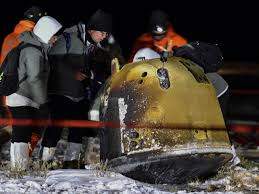China Moon Mission Ends as Lunar Probe Returns to Earth With Fragments

China’s space program executed the final stage of an ambitious mission to capture moon fragments and return them to Earth, state media reported, as its space vehicle touched down in a northern China landscape covered in snow.
The parachute’s landing early Thursday local time amid darkness in Inner Mongolia came more than two weeks after China landed its Chang’e 5 probe on the moon on Dec. 1. The successful return of a lunar landing craft to Earth is the world’s first since a Soviet mission in 1976.
China Central Television coverage showed the craft intact and nestled in the snowy ground and being approached by helicopters. It took some time after it touched down for ground crews to locate the roughly 3-foot-wide capsule in the dark and state media cited challenges in getting vehicles across the flat expanse to retrieve it.
China’s complicated Chang’e 5 mission began on Nov. 24. The space vehicle included orbiter, lander and ascender with maneuvers that included reuniting spacecraft 200 miles from the lunar surface for a transfer of captured moon material before firing off for a return to Earth.
The Chang’e 5 probe, China’s third exploration on the moon’s surface, had spent 19 hours on the surface and used robotic equipment to drill about 2 feet deep to recover around 4.4 pounds of rock and material. “These samples will be studied to uncover clues to the moon’s multi-billion-year history,” according to a report by CCTV, the state broadcaster.
The China National Space Administration’s updates throughout the mission have cited success with Chang’e 5’s tricky maneuvers and pride in “retrieving China’s first samples from an extraterrestrial body.”
Reports by Xinhua News Agency said that while on the moon the probe withstood temperatures exceeding 212 degrees Fahrenheit and deployed technology such as regolith-penetrating radar. “Diverse samples at different sites have been gathered,” Xinhua said, adding that the material was vacuum-sealed for safe return to Earth.
A statement from Chinese President Xi Jinping published in state media called the mission a complete success and a step forward for the country’s aerospace program.
China sent the Chang’e-5 spacecraft to collect and bring back to Earth samples from the moon. WSJ’s Trefor Moss reports on why the success of this mission could be a milestone for the country's young but ambitious space program. Photo: Jin Liwang/Xinhua/Zuma Press
China becomes the third nation after the U.S. and the former Soviet Union to manage the return of lunar samples. The Chang’e 5 mission planted China’s flag on the moon’s surface before departing.
The U.S., the only nation to put a man on the moon, last did so in 1972. The Soviet Union’s successful mission in 1976 to return around 6 ounces of moon material to Earth was its third attempt to do so, according to the U.S. National Aeronautics and Space Administration. China first reached the moon in 2009 and by 2013 had put a rover on its surface.
Exploration of the moon, along with probes of Earth’s mountaintops, seabed and polar extremes, marks China’s effort to build up its scientific capabilities and boost national pride. As if to underscore China’s continuing space ambitions, the country on Wednesday positioned a Long March-8 carrier rocket on a launch site in southern Hainan Island ahead of a test flight later this month aimed at developing reusable space equipment. Within a decade, China hopes to establish a base on the moon for people and further explore deep space.
Chinese scientists have expressed interest in the moon’s supply of helium-3, a potential energy source, as well as its potential for water as a life source and rocket fuel.
Photo: Recovery crew members check on capsule of the Chang’e 5 probe after it landed in Siziwang district, north China's Inner Mongolia Autonomous Region, in this photo released by Xinhua News Agency. - REN JUNCHUAN/XINHUA/ASSOCIATED PRESS
Link: https://www.wsj.com/articles/china-moon-mission-ends-as-lunar-probe-returns-to-earth-with-fragments-11608147926




